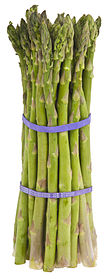Asparagus
| Asparagus | |
|---|---|
 |
|
| A bundle of cultivated asparagus | |
| Scientific classification | |
| Kingdom: | Plantae |
| Clade: | Angiosperms |
| Clade: | Monocots |
| Order: | Asparagales |
| Family: | Asparagaceae |
| Subfamily: | Asparagoideae |
| Genus: | Asparagus |
| Species: | A. officinalis |
| Binomial name | |
|
Asparagus officinalis L. 1753 |
|
| Synonyms | |
|
List
|
|
 |
|
|
|
| Nutritional value per 100 g (3.5 oz) | |
|---|---|
| Energy | 85 kJ (20 kcal) |
|
3.88 g
|
|
| Sugars | 1.88 g |
| Dietary fibre | 2.1 g |
|
0.12 g
|
|
|
2.2 g
|
|
| Vitamins | |
| Vitamin A equiv. |
(5%)
38 μg
(4%)
449 μg710 μg
|
| Thiamine (B1) |
(12%)
0.143 mg |
| Riboflavin (B2) |
(12%)
0.141 mg |
| Niacin (B3) |
(7%)
0.978 mg |
| Pantothenic acid (B5) |
(5%)
0.274 mg |
| Vitamin B6 |
(7%)
0.091 mg |
| Folate (B9) |
(13%)
52 μg |
| Choline |
(3%)
16 mg |
| Vitamin C |
(7%)
5.6 mg |
| Vitamin E |
(7%)
1.1 mg |
| Vitamin K |
(40%)
41.6 μg |
| Minerals | |
| Calcium |
(2%)
24 mg |
| Iron |
(16%)
2.14 mg |
| Magnesium |
(4%)
14 mg |
| Manganese |
(8%)
0.158 mg |
| Phosphorus |
(7%)
52 mg |
| Potassium |
(4%)
202 mg |
| Sodium |
(0%)
2 mg |
| Zinc |
(6%)
0.54 mg |
|
|
|
|
|
| Percentages are roughly approximated using US recommendations for adults. Source: USDA Nutrient Database |
|
Asparagus, or garden asparagus, scientific name Asparagus officinalis, is a spring vegetable, a flowering perennial plant species in the genus Asparagus.
It was once classified in the lily family, like the related Allium species, onions and garlic, but the Liliaceae have been split and the onion-like plants are now in the family Amaryllidaceae and asparagus in the Asparagaceae. Asparagus officinalis is native to most of Europe, northern Africa and western Asia, and is widely cultivated as a vegetable crop.
Asparagus is a herbaceous, perennial plant growing to 100–150 cm (39–59 in) tall, with stout stems with much-branched, feathery foliage. The "leaves" are in fact needle-like cladodes (modified stems) in the axils of scale leaves; they are 6–32 mm (0.24–1.26 in) long and 1 mm (0.039 in) broad, and clustered four to 15 together, in a rose-like shape. The root system is adventitious and the root type is fasciculated. The flowers are bell-shaped, greenish-white to yellowish, 4.5–6.5 mm (0.18–0.26 in) long, with six tepals partially fused together at the base; they are produced singly or in clusters of two or three in the junctions of the branchlets. It is usually dioecious, with male and female flowers on separate plants, but sometimes hermaphrodite flowers are found. The fruit is a small red berry 6–10 mm diameter, which is poisonous to humans.
Plants native to the western coasts of Europe (from northern Spain north to Ireland, Great Britain, and northwest Germany) are treated as Asparagus officinalis subsp. prostratus (Dumort.) Corb., distinguished by its low-growing, often prostrate stems growing to only 30–70 cm (12–28 in) high, and shorter cladodes 2–18 mm (0.079–0.709 in) long. It is treated as a distinct species, Asparagus prostratus Dumort, by some authors.
...
Wikipedia
